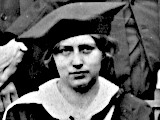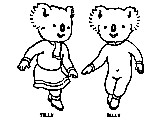

|

|
Mary Bailey(1909-2003) |

|
||
|
The photograph above left is courtesy of the Royal College of Art Archive, to which I am also indebted for the information that Mary's middle name was Frances, which has hopefully enabled to me to correctly identify her as the person profiled below.
On 9 December 1934 The Sunday Express carried an article by their film critic Ernest Betts about the London animation studio of Australian cartoonist Dennis Connelly and his cartoon films starring koala bears Billy and Tilly. I quote the following extract: When I first saw "Billy and Tilly" last February, Mr. Connelly had not succeeded in making them behave as a bear should do in the company of critical filmgoers. Mary Frances Bailey was born in Bath, Somerset, on 26 December 1909, the second child of piano tuner Richard Tarrant Bailey and his wife Mary. Richard and his wife were both keen banjo players, and formed a local banjo club in Bath. The children were also members of the club, and Richard Tarrant Bailey Junior, became a virtuoso banjoist, travelling the country and appearing on the radio. Mary, known, apparently, as "Mouse" within the family, showed an aptitude for art, and in 1927 attended the Royal College of Art, in London. She gained her ARCA (Associate of the Royal College of Art) Diploma (School of Drawing and Painting) in 1930, but she seems to have stayed on for a further year. By 1934 she had been recruited by Dennis Connelly at his studio in Greek Street, and was working on the first "Billy and Tilly" cartoon. Despite glowing reports Billy and Tilly was not considered good enough to get a release, but it did win Connelly a contract with the London office of MGM for a series of six new cartoons starring the Koalas. (American studios with distribution offices in the UK had to offer a set proportion of British-made films.) Connelly formed a limited company and relocated his studio to larger premises above The Ivy restaurant, a popular haunt for theatrical personalities, and increased the staff to 40 or 50, predominantly young women. The big advantage of this was that in 1935 a trained woman could expect a wage as little as half that of a similarly qualified man, especially if she had not yet established herself in a career. And, of course, it was considered that women were more capable than men at maintaining a high output when performing precise and repetitive tasks. As an early instance of a British-made colour cartoon, Billy and Tilly, the first attempt, had received praise despite its shortcomings. But by 1935 Connelly had competition. A renown British animator from the silent era, Anson Dyer, was keen to get back into making entertaiment films, and in early 1935 the wealthy film producer Archibald Nettlefold set him up in his own animation studo, Anglia Films. Dyer acted as producer and the animation was handled by a team that had honed their skills making advertising films. Dyer made a series of cartoons featuring Sam Small, the stubborn protagonist of Stanley Holloway's comic monologues, ("Sam! Sam! Pick oop tha' moosket!"), which were released from the end of 1935 throughout 1936. Though moderately successful, the high cost of these films meant that they never made sufficient money to sustain the studio. In comparison with Dyer's first films, Connelly's first two entries in the Billy and Tilly series for MGM, Dick Whittington and Robin Hood appeared rather underwhelming. After a short release the series was abandoned, and Connelly's studio went into liquidation at the start of 1936. As far as I can tell, Mary Bailey did not have any further involvement in animation. Her entry in the 1939 Register shows she was working in a school in Stafford as an assistant Art Mistress. I have been unable to trace Mary's subsequent career, but she eventually returned to live in the family home, Ensleigh Lodge, Lansdown, Bath. Mary Frances Bailey died on 25 October 2003, at the age of 93. |
||||
Filmography |
||||
| Billy and Tilly | (Dennis Connelly, 1934, not released) | |||
| Dick Whittington (Billy and Tilly) | (Dennis Connelly, 1935, not released) | |||
| Robin Hood (Billy and Tilly) | (Dennis Connelly, 1935) | |||
Links to Other Sites |
||||
|
Peter Hale
Last updated 2025
|